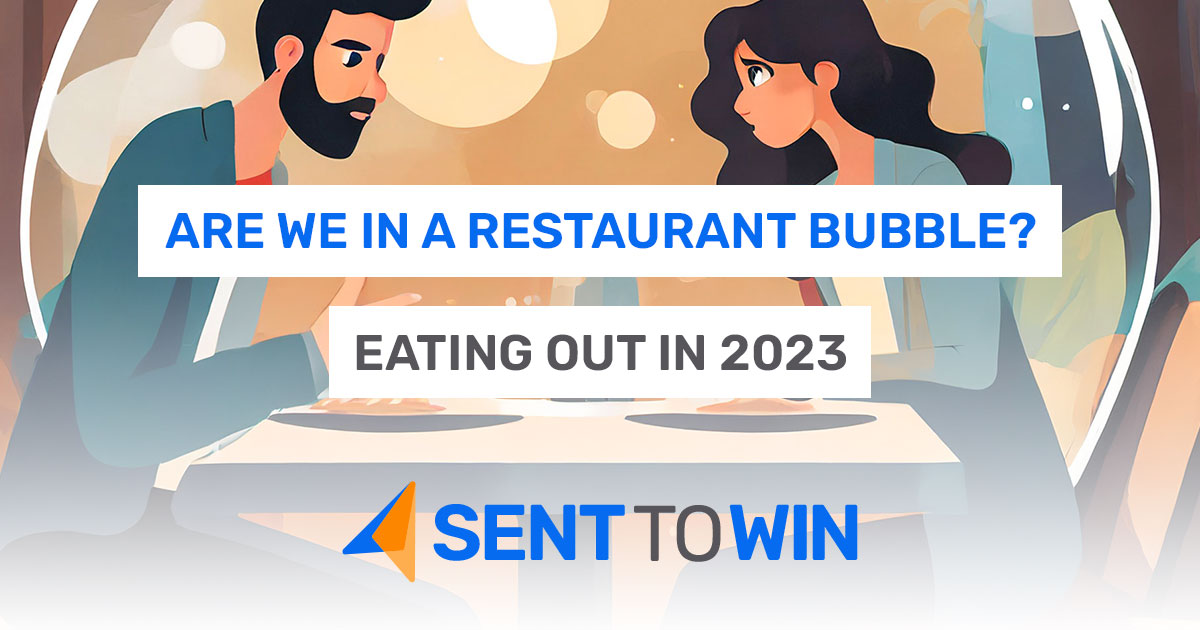Are We in a Restaurant Bubble?
We’ve all felt it.
Whether it’s a nice evening out with a few friends, or a quick meal at a fast-food restaurant, it can be shocking to see the total at the bottom of the bill. It seems like eating out is a different (and costlier) experience than pre-pandemic, but if you’re like most people, you don’t keep a detailed log of the prices, so it can be hard to know for sure. Inflation has been high the past few years, but still something seems off.
A recent post on X, where a father of four young kids complained about the untenable price of eating out, went viral, eliciting strong reactions, comments, and agreement. He mentions that eating at Panera cost him $73, a local grill was $78, and even IHOP rang in at over $60 for a low quantity of non-specialty food. So, we decided to do a quick, unscientific survey of our own where we spoke to readers from 12 different states across the country to hear what they think about the cost of eating out in 2023 and how they feel about the experience. Here’s a sampling of what we found:
Do you feel that the cost of eating out right now is generally a good value, about what you would expect, or not a good value?
“Not a good value.” – Aimee, California
“It’s not a good value. I don’t [eat out] as much as I used to.” – Rick, New Mexico
“It’s too expensive.” – Damond, North Carolina
“In the last couple of years, not a good value.” – Vince, Georgia
In all, every person we spoke to felt that eating out was not a good value, with the exception of one man in Texas, single and in his early twenties, who said that it was a good value to him – but only because it allowed him to spend more time on sales. He was quick to acknowledge that his usual lunchtime order had recently increased 50%. The only other respondent who felt that eating out was a good value was a young married couple in Seattle, Washington, who do not yet have kids, and they emphasized the fact that Seattle has a lot of very high quality restaurants that make the experience worth the cost. Everyone else was quick to say, “Not a good value.”
In general, the people we spoke to have reduced the amount of times they eat out per week, largely due to cost, but there were other factors driving that behavior as well:
Have you noticed any changes in the general dining out experience the last couple of years?
“Oh yes. They’re always understaffed. There used to be a spirit of, I don’t know, fun? It just doesn’t seem as fun anymore.” – Roxanne, Tennessee
“Customer service is bad.” – Jacob, Utah
“The portion size has gone down, prices have gone up, and the overall attitude of the employees and service has degraded significantly. There are a few establishments withstanding, but as a whole I hold to that opinion.” – Vince, Georgia
“The service has declined, the cost increased, and the quality of food declined.” – Damond, North Carolina
“The quality has definitely gone down. Way less servers, longer waits.” – Aimee, California
Most agreed that the quality of service had declined, with the exception of Tanner, from Missouri, who actually felt that service had gotten a little better in the last couple of years, but he did point out that wait times were very bad, because establishments do not have sufficient numbers of employees.
“There was a Chili’s near where I live where only the bar was open for 6 months, because they didn’t have enough staff. – Tanner, Missouri
Paul and Brittany, from Washington, noted that eating out felt normal again now that COVID restrictions are a thing of the past, but they mentioned that some details of the dining experience have changed.
“You can order online… you see a lot more of the paperless menus and QR codes. There is a lot more technology involved in the exchange.”
Food delivery apps are affecting how people see restaurants as well – whether they are using them or not.
“Sometimes [in line] there are as many people working for Door Dash and Uber Eats as there are people waiting to get their own food. On-the-go is super emphasized.” – Wesley, Alabama
The result? Longer wait times.
Finally, the issue of tipping came up, unprompted, in many of the interviews we conducted. And people were not happy about it.
“People are entitled for tips… It used to be for if you did a good job, but now it’s like tips are expected, and not even just a 15% tip. It’s a 20% tip, especially when they throw a screen in front of you with a preselected amount.” – Kyle, Florida
“The tipping frenzy has gotten berserk. If I’m at a sit-down restaurant, I’m more than happy to pay a server for their job. For somebody running a cash register, sorry, but no thanks. This is coming from someone with 21 years of experience in the industry.” – Vince, Georgia
We spoke to Russel Wehesner, a restaurant developer in Texas, about the perception of rising costs, the decline in quality, and restaurants seemingly being run by a skeleton crew. He had this to say:
“Staffing is an issue, but the main problem is rent. I have a large chain restaurant that just finished up a 15-year lease and had to sign another one. They started at 100k in rent per year, now it’s suddenly 300k, and their health ratio is 11%. You really want to be under 8% as a restaurant. Cost of construction is up 50% in the last three years, so it’s just going to be tough for new restaurants, because the numbers are going to be so high to make it work for the developer.”
Tripling rent would crush just about anybody, and this was for a large, established chain. Other establishments don’t have the same bargaining power, and the cuts have to come from somewhere. So, we have smaller portions, higher prices, lower quality ingredients, fewer employees, and longer waits.
“People are still paying [the high prices in restaurants],” Russel continued. “but it’s just a matter of ‘how long will it last?’ The rents are insane, and it’s been a burden for a lot of groups.”
But what does it mean to say it’s a matter of ‘how long it will last’? People don’t have to eat out at all, in the majority of cases. Dining out is technically a luxury good, and widespread behavior change in this industry’s consumption could cause a cascade of restaurant failures, resulting in even more consolidation than we’ve seen already. And people are noticing the effects of the strange economy on their dining options.
“There’s not a good selection of mom and pop stores,” says Jacob of Utah. “There’s not a lot of family-owned restaurants to choose from that would do lunch deals and things like that. I miss that.”
“It seems like owners are a lot more money-conscious. I don’t blame them really, but it’s expensive, so we just don’t go out to eat as much now.” – Ashe, Montana
“The quality of the food is very similar to what you’d get at Wal-Mart…” – Wesley, Alabama
“Restaurants have marketed themselves as healthier than they actually are while still cutting corners to save on cost, rather than offering good, healthy food.” – Kyle, Florida
“It just feels like there are less and less unique restaurants, and more and more of the same thing over and over, and that makes me sad.” – Tanner, Missouri
“As a mom, it’s hard to cook every night, and you want something for when you’re tired. It’s just way too expensive now, and that’s a bummer.” – Aimee, California
Leaving our anecdotes and diving into more rigorous data, the results are the same: Restaurant prices keep going up, quality is down, and the trend lines are not good. Some have pointed out that the value proposition for fine dining has largely remained unchanged in recent years, and there is some reason to think people are less upset with the steakhouses of the world than they are with Chick-fil-A, Olive Garden, et al. But most consumers cannot afford to go to Ruth’s Chris three times a week, or even weekly, and an overall reduction in eating out might be taking place.
So, the industry may be in crisis, but in every crisis, there is an opportunity for those with the wit and willingness to innovate new solutions to serve their customers. Yet as economic pressures seem to hit restaurants from all sides – real estate, supply chain, inflation, customer price-resistance, debt burden, etc. – is there still room for casual dining and fast food in the modern economy?
Only time will tell.

“Thank you for your donation – would you like to tip 18%, 20% or 25% on that transaction?”
Quick Hits
- Puerto Rican superstar rapper Daddy Yankee announces his retirement from music so that he can devote his life to following Jesus.
- Office Christmas parties scale back this year, given the state of the economy and shifting employee priorities.
- The Wall Street Journal says that buying a house just doesn’t make sense right now, and brings the data to prove it.
- A federal judge has ruled that World Vision’s policy that marriage is between one man and one woman is unlawful discrimination under Title VII.
- Scott Klusendorf offers a strategy for pro-life messaging in the state by state debate.
- Annualized inflation came in at 3.1% for November.
For Kingdom Leaders, By Kingdom Leaders
Bringing Kingdom-minded leaders like you fresh perspectives and insights on business, finance, and leadership trends.




